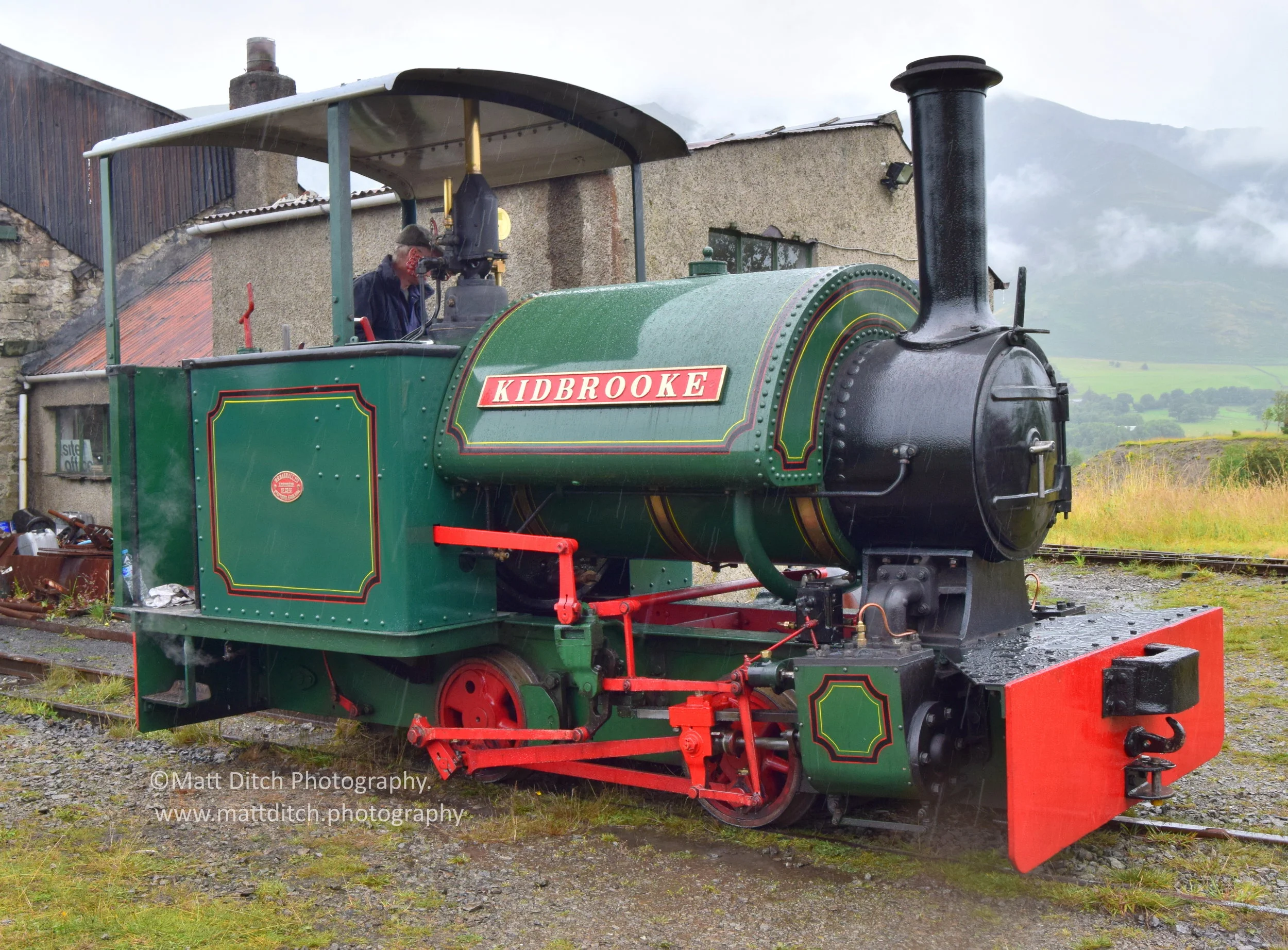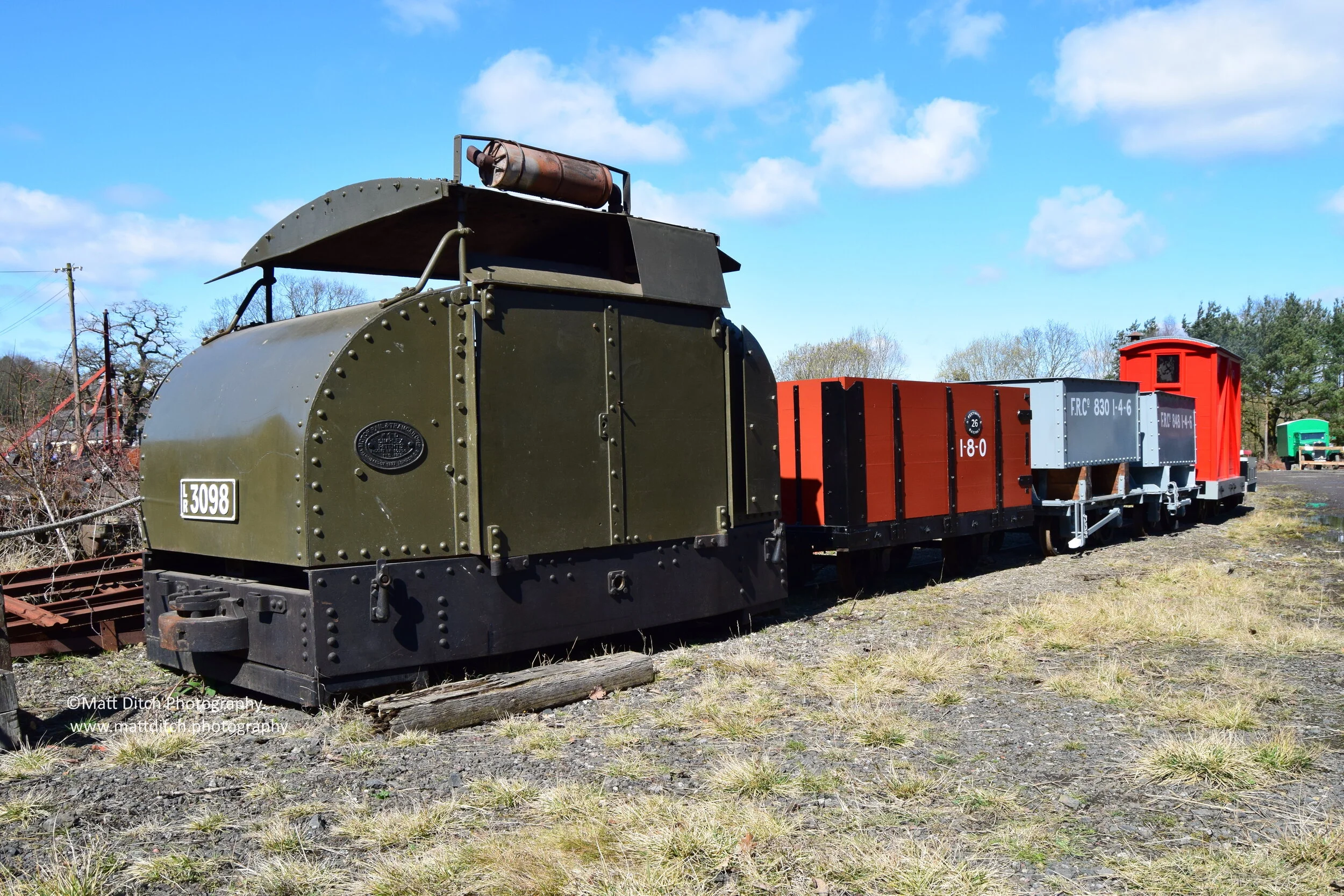Cawfields Quarry Railway
Kerr Stuart "Sirdar" class 0-4-0T "Vyrnwy" crossing high Mill bridge. The engine shed can be seen behind the wagons. The above picture can be seen on an information board for the burn neat the start of the walk. The orignal picture was taken by J.Keen.
History & the route
Many in the narrow gauge community will be familiar with
the town of Haltwhistle as the planned terminus for the South Tynedale railway from Alston,
who hope to return to the town within the next several years. But the South
Tynedale won’t be the first narrow gauge railway within the town.
By Roger Cornfoot © Creative Commons
In
1905 a narrow gauge railway was constructed to link the Newcastle &
Carlisle railway with the Whinstone quarry at Cawfields, near Hadrian’s wall. Part of the line was built on a pre-existing Tub way that linked South Tyne Colliery with the South Tyne Colliery screens at Townsfoot. A number of bridges on the route and embankments had to be widened to accommodate the new railway. Today the route through Haltwhistle burn to the quarry is a very pleasant walk
with many remaining industrial features.
For me, the walk started at Halthwislte station, the
overgrown platform pictured to the left will be used by the South Tynedale
railways trains from Alston.
The start of the walk and the course of the line to
Cawfields is a short walk from the station. To walk the full length, you have
to exit the station and turn right onto the B6322. After a short walk you will
reach the site of the loading dock, stone tip and South Tyne colliery screens
at Townsfoot. Since closure of the railway this site has been heavily developed
and no trace of the narrow gauge railway remains. From here there is a short
footpath along the side of Haltwhistle burn that will bring you out at the
first clear remains of the railway.

The bridge abutments from Castle bank bridge, which once carried the line over
Castle Hill Terrace.As mentioned above these abutments were extended when the railway was built to run alongside the pre-existing Tub-way. Following the railway from here may not seem obvious to
begin with, but by crossing over the road and heading down a small lane you
will quickly pick up the trail again. The small lane will come to an end in front of a row of cottages, with Haltwhistle burn running in front of them. It’s at this point that the railway first crossed the burn over Oakwell bridge. The remaining abutment pictured below. An engine shed existed between Oakwell bridge and Castle bank bridge.

To
gain access to the trackbed one must cross the footbridge that links to the row
of cottages, this bridge appears to have been constructed from narrow gauge
rails . The path then swings behind the cottages before climbing to meet
the trackbed as it comes away from the site of Oakwell bridge as the below image shows.
After a short walk the path reaches the site of South Tyne Colliery. And engine shed also existed on this section. The Colliery was opened sometime in the 1860s and lasted till the early 1930s. Today many of the old buildings still stand and are still in use. During my walk I spotted a Fowler 8726 - BS 8535 stored in an outbuilding, so thankfully there is steam in Haltwhistle burn.
After the colliery closed many of the workers moved onto work the mines around Ashington, just north of Newcastle. The below image shows the bricked up entrance to South Tyne drift mine. It was later used as an air shaft. A horse drawn tramway ran from here to Townfoot till the 1950s.
Coal mining and stone quarrying weren't the only industries in the burn. There were a number of Clay pits and Brick & Pipe works. The Brick works were located on the opposite side of the Burn to South Tyne colliery. The works also used clay from South Tyne Colliery. But, the main clay pit was located high above the burn and was linked to the works via a tunnel which ran from the pit, under the "Cat Stairs", an ancient right of way located near the South Tyne drift where the tunnel came out.
Continuing passed the site of South Tyne Colliery the railway passed High Mill yard and crossed the burn on High Mill bridge. The orignal bridge was built from reclaimed tram track. A gate was fitted here to stop wandering farm animals.The above picture shows the trackbed looking towards the site of Lees Hall/ Herdmans Stone quarry (middle left of the picture). in the direction of Cawfields Quarry.
After passing over Foxhole bridge the next feature of interest on the trackbed is the Fell Chimney. The Chimney was once part of "The Fell drift/ East end pit". A steam powered pump and hauler existed here. The pump was used to pump water out of the mines and the hauler brought loaded coal tubs up from the mine. Some foundations also exist here from the other buildings.
From the Fell Chimney the burn starts to open up and the trackbed passes a number of lime kilns. The coal used to fire these Kilns came from the nearby Fell drift. A holiday home, now presumed abandoned was built towards the end of the burn at some point in the 1930s. The building looks vaguely like a station building and sat just off the track.
The railway then passed under the roman built "Military road" via a girder bridge, similar to others on the line. The bridge stretched from one side of the river side to the other. The railways steam loco "Vyrnwy" had reduced height fittings (cab/ chimney) to allow it to pass under this bridge. It would appear since the line closed that the bridge has been rebuilt and the headroom reduced. The route of the railway towards Cawfields can be picked up again by following the path from the burn onto the Military road and then crossing over and following the signs for Cawfields. Although it should be noted that this section can get extremely muddy!

From here the railway continues running along the side of the Burn. It skirts the edge of a Roman camp, the remains can be seen on Google Earth near the Milecastle Inn. The railway also crosses the route of the course of the "Vallum" and Hadrian's Wall before finally reaching Cawfields Quarry (pictured above). Quarrying here actually cut through the Roman Wall, the wall ends on top of the old quarry face above. The Quarry finally closed in October of 1952 and Today the quarry itself is mostly flooded and is the starting place for many walks.
Freshy cut stone from the quarry was fed into a stone crusher via an incline (hand/horse worked). After the stone had passed through the crusher it fell onto a conveyor belt that conveyed it into the screening plant. Wagons were placed under the hoppers and the crushed stone was loaded into them for the journey down the line to Townsfoot. A newer crushing plant was also constructed here in the 1930s which could fill road vehicles in addition to railway wagons.
Locomotives
SAR Class NG1 40 (0-4-0T) Unknown author, Public domain, via Wikimedia Commons.
A similar Kerr Stuart "Sirdar" class 0-4-0T was used on the Cawfields Quarry Railway
The railways main locomotive was a Kerr Stuart "Sirdar" class 0-4-0T (748 of 1902). The engine originally built for Kirk Knight & co for the construction of Lake Vyrnwy reservoir in Wales. The engine is thought to have been scrapped in the mid 1930s at the engine shed near South Tyne colliery when it was discovered to have issues with its firebox. By this time the engine, which some had nicknamed "The Varney" was mainly used to shunt at the Townsfoot end of the line. One reports suggests it was sent to a quarry near Alston. But, this is actually thought to have been a Barclay well tank that may have came from the construction of Burnhope reservoir.
"Diana" shunting V-tipper wagons at Threlkeld Quarry. Trains on the Cawfields Quarry Railway would have looked very similar to this.
A small number of Sirdar's are thought to survive abroad but thankfully one also survives in the UK. "Diana" (pictured above) is a long tank variant which worked at the Kerry Tramway in mid Wales and a number of slate quarries in North Wales. It is now based at the Amerton railway in Staffordshire.
"Mountaineer" would have appeared very similar to Bagnall 0-4-0ST "Kidbrooke".
In addition to the Sirdar the railway also had a small 0-4-0 saddle tank name "Mountaineer" (Works Number 1446). This was the railways first loco and was delivered new in 1896, several years before the railway opened. It was built by Bagnall for Hurst Nelson of Glasgow. During the winter of 1924 "Mountaineer" was offered for sale to the Ffestiniog railway in Wales. They declined as the engine was too small for there needs, it was eventually scraped around 1930.
In 1920 the steam engines were joined by a petrol engined armour plated Simplex nickname "The Tank". This engine has been built for the War Office in 1918 to work on the trench railways in France. Many of these engines survive to this day. The above image shows the National Railway museums example which is currently based at Beamish Museum.
©Spoorjan Creative Commons Attribution-Share Alike 3.0 Unported, 2.5 Generic, 2.0 Generic and 1.0 Generic license.
The railways second petrol locomotive was built by American company Whitcomb. It is believed to have been nicknamed "The General" and was thought to have been built for the French Navy for use in a shipyard. The above picture shows a similar Whitcomb diesel to Cawfields.
Conclusion
As the above pictures show today the course of the railway up the burn is a very pleasant and scenic walk. And, if you know where to look you can see traces of its former life. It seems highly unlikely that the railway will ever reopen. Castle Bank and Oakwell bridges would need to be completely rebuilt and the bridge under the Military road appears to have been rebuilt and the opening reduced in height. However the idea of reopening it was floated in the 90s. Information on this scheme is sadly extremely thin on the ground. It is hoped that in the next several years that the South Tynedale railway will be able to extend from their current terminus at Slaggyford back into Haltwhistle once again giving the town a narrow gauge railway. Stanegate Restorations and Replicas are based in Haltwhistle an often undertaken restoration of narrow gauge vehicles. So you could say narrow gauge has never really left Haltwhistle.
If you'd like to see some more detailed photos of the railway and uts related industries then I highly recomend the book "Cawfields Quarry and Railway" by John Parker.
If you’ve enjoyed this then please consider supporting this website so that I can continue to deliver new content like this. Patreon and Ko-Fi




















Thanks for this - very interesting and brought back memories of walking up the path from Haltwhistle about ten years ago. On this, though - the Military Road was not built by the Romans, but by the British Army in the aftermath of the 1745 Jacobite rebellion, when the troops at Newcastle hadn't been able to get across to Carlisle fast enough to catch the Jacobites. The Roman road here is known as the Military *Way*, and runs between the Vallum and the Wall. The quarry line I think crossed the military way just south of where the road from the Milecastle Inn crosses the Haltwhistle Burn.
ReplyDelete